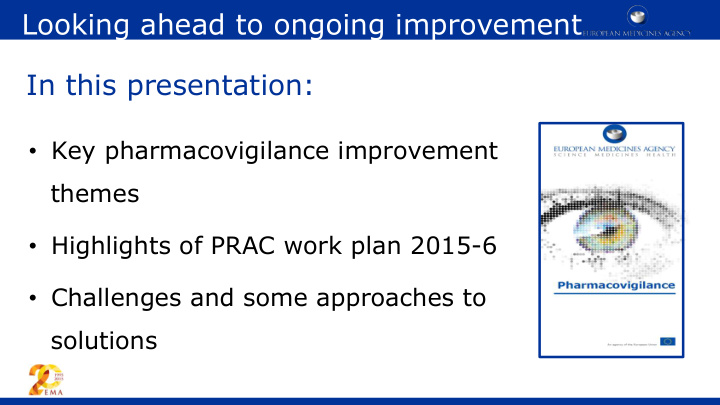



Looking ahead to ongoing improvement In this presentation: • Key pharmacovigilance improvement themes • Highlights of PRAC work plan 2015-6 • Challenges and some approaches to solutions
PRAC activities 36 PRAC meetings Over 150 Over 600 risk protocol management reviews plans 68 safety referrals Over 300 Over 1000 signals PSURs
PRAC Improvement themes Keeping up the PACE Making a difference
Keeping up the PACE Proactive & Accessible prompt public and open PhVig health systems protection Collaborative Effective & convergent decisions and throughout systems lifecycle
The 2015-6 PRAC Work Plan Comprehensive activity- focussed plans to utilise potential of all new legislative tools Priorities include: Enhanced quality and consistency • of PRAC benefit risk reviews Product lifecycle support • Use of new tools – PAS/PAES • Focus on developing new guidance where needed –special populations Strengthened collaboration with key stakeholders
Proactive public health protection • Strengthening evidence and science base Proactive & prompt public • Investigating use of benefit risk decision health methodologies protection • Focus on Post Authorisation studies – PASS and PAES • Signal detection methodologies • New guidance Special populations • Biologics and vaccines • Pregnancy • Medication errors •
Vaccine vigilance Example : Observed vs expected Rotavirus and Intussusception MaxSPRT for Intussusception with Rotarix - 1 week risk window (first vaccination only, assuming RR=6.8 based on Australian data) 10 9 8 7 Log-likelihood ratio 6 5 4 3 2 1 0 1 2 3 4 5 6 7 8 9 10 11 12 13 14 15 16 17 18 19 20 21 22 23 24 25 26 27 28 29 30 31 32 33 34 35 36 37 38 39 40 41 42 43 44 45 46 47 48 49 50 51 52 10% reporting 25% reporting 50% reporting 75% reporting 100% reporting Critical threshold Week
Signal management Pacurariu et al Drug Safety 15 Nov 2014 Pacurariu et al Drug Safety 15 Nov 2014
Patient & healthcare professionals nt & Disconnect between product information & clinical experience – impact on patient compliance Review of anti-retrovirals and lipodystrophy warnings Scientific evaluation supported risk proportionate approach to product information Example of keeping class warnings up to date in light of clinical experience Henghel et al, Lo et al Lancet 1997, 1998
Use of pharmacogenomics for RMMs EU Guideline on pharmacogenomics in pharmacovigilance finalised 27 October 2015
Transformative medicines Early access to medicines in areas of high unmet need PRIME (Priority Medicines) medicines procedures under development Focus on real-world real-time evaluation – adaptive pathways ADA-SCID gene therapy
Accessible pharmacovigilance systems Accessible and open Experience of engagement of PhVig health professionals and patients systems in referrals (safety reviews) Introducing public hearings Optimising safety communications Report on experience with co- ordination of EU communications
Engaging with patients and the public Interaction with patient and healthcare professional organisations so far ad hoc during formal European safety reviews Rules of procedure for conduct of public hearings being finalised First public hearings expected early next year
Optimising pharmacovigilance communications PRAC will be supporting work by EMA on risk communication Focus is initially on work with healthcare professionals
Collaborative pharmacovigilance Working with internal and external stakeholders – building effective international collaboration EU Joint Action project “SCOPE” Innovative Medicines Initiative Collaborative “WEB-RADR” & convergent throughout lifecycle
SCOPE EU Joint Action Strengthening pharmacovigilance collaboration: • ADR reporting • Signal detection • Risk communications • Pharmacovigilance assessment • Quality management Project due for completion October 2016
Innovative Medicines Initiative WEB-RADR project Development of a mobile app for – ADR reporting – Provision of information to users Modern pharmacovigilance technology Scientific evaluation of using social media data to identify ADRs, propose policy guidance
Effective pharmacovigilance systems Developing strategy to strengthen evaluation of risk minimisation proposals Developing a strategy to measure impact of pharmacovigilance Effective decisions and systems
Example Impact of regulatory action Removal of first-line indication in osteoporosis for HRT after WHI study showed harms Followed by fall in incidence of breast cancer in women over 50 eg 7% in Australia Trends in use of hormone therapy for the menopause since 1970
HRT and breast cancer warnings
Some key challenges Ongoing development of signal detection approaches Optimising benefit risk assessment of “mature” products Long term safety (biologics) Vaccine vigilance Medicines in pregnancy
Some approaches and solutions Maximising use of new methodologies from collaborative research in particular PROTECT Building capacity for PASS and PAES studies by use of European Network of Centres for Pharmacovigilance & Pharmacoepidemiology Better use of real-world data eg registries, observed versus expected analyses Regular strategic review and learning meetings with other EMA committees
Conclusions Last three years have seen great progress in realising potential of EU Pharmacovigilance legislation & role of PRAC Experience has demonstrated areas where a strengthened , clarified or simplified approach needed This is the basis for developing a work plan for 2016 with a clear focus on best evidence and new methodologies Ongoing collaboration between all stakeholders in a European networked model essential to achieve highest standards of public health protection
Thank you European Medicines Agency 30 Churchill Place • Canary Wharf • London E14 5EU • United Kingdom Telephone +44 (0)20 3660 6000 Facsimile +44 (0)20 3660 5555 Send a question via our website www.ema.europa.eu/contact Follow us on @EMA_News
Recommend
More recommend